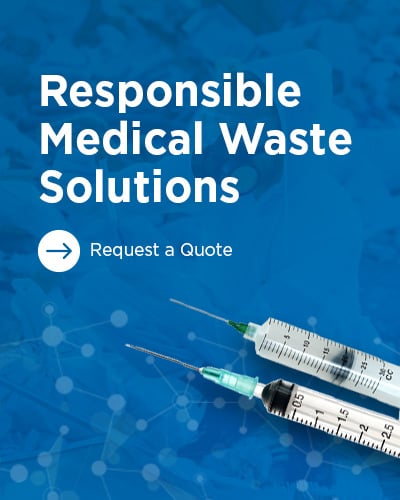 Lisinopril - What is it
Lisinopril - What is it
Myocardial infarction (heart attacks), hypertension (high blood pressure), and heart failure are serious problems in the medical world, specifically involving individuals 45 and up. How do we prevent these medical emergencies from happening? Medications called ACE inhibitors such as Lisinopril are used to hinder the possibility of narrow blood vessels from causing high blood pressure, and therefore, heart attacks. In the article below, you will find the definition of Lisinopril, dosing, proper dosage, side effects, and the disposal of Lisinopril. PureWay can help you safely dispose of unused or expired medications such as Lisinopril by using regulated medical waste containers, for your benefit!
What is Lisinopril?
First, we will begin with a simple definition to better understand what Lisinopril is and its purpose. Lisinopril is an Angiotensin-converting enzyme (ACE) inhibitor as stated by Mayo Clinic. An ACE inhibitor includes medications prescribed to relax the veins and arteries in order to decrease blood pressure, not heart rate. ACE inhibitors thwart a specific enzyme produced in the body from forming angiotensin II (hormone), which causes blood vessels to narrow as a result of this substance. Examples of ACE inhibitors listed by the FDA include Benazepril, Captopril, Fosinopril, Lisinopril, and more. Lisinopril, also known by its brand names Zestril and Prinivil, is used specifically to manage high blood pressure and improve survival rates in patients with heart failure, says Pubmed. We know that Lisinopril blocks angiotensin II from being made, but to understand how important that is, we have to know what angiotensin II does. Angiotensin II raises blood pressure by making blood vessels thin out, and it also helps in the release of Aldosterone. The hormone Aldosterone raises blood pressure by causing the kidneys to hold on to salt and water, says GoodRx Health. Retaining too much salt and water in the body can result in high blood pressure. Lisinopril is proven to be beneficial for people who have had a heart attack and can be used long-term to prevent another attack from occurring in the future.
Lisinopril Dosing
Now that you know what Lisinopril is and what it does, I’ll inform you of where you can find dosing. Lisinopril is a medication taken by mouth as prescribed by your doctor and the amount taken is based on your medical condition, response to treatment, and sometimes weight (mainly for children). It is important that you do not overdose on Lisinopril because of the dangers that could arise to your health. If you miss a dosage, do not double up on the next one to make up for it. Follow the dosage schedule set for you by your doctor carefully. The dose of this medicine will be different for different patients. Below are the average doses of Lisinopril medicine. Do not change your dosage unless your doctor tells you to do so. The number of doses you take each day, the time allowed between doses, and the length of time you take the medicine depend on the medical problem for which you are using the medicine (Mayo Clinic).
- Regarding high blood pressure (hypertension) in adult patients, start with 10mg once per day. This amount may vary based on your medical necessities, but the dose is usually less than 40mg a day.
- For children 6 years of age and up, the dosage is determined by your doctor through body weight. Starting dose is usually around 0.07 milligrams per kilogram of body weight each day. Dosage varies depending on the doctor's recommendations and the child's weight. The average dose normally doesn’t exceed 0.61 mg per kg of body weight.
*NOTE- Children under the age of 6 are not recommended to take Lisinopril*
For heart failure, adults start with an average of 5 mg once a day and normally do not exceed 40 mg per day. For children, the dosage is decided by your doctor based on medical needs.
Following the immediate treatment after myocardial infarction (heart attack), adults start with 5 mg and gradually increase dosage according to the doctor’s assessment. This usually accumulates from 5 mg after 24 hours of first dose, then 10 mg after 48 hours, and eventually to 10 mg per day. The amounts are different for children and are decided by the doctor.
How to take Lisinopril
This particular medication comes in the form of generic lisinopril tablets, brand names such as Zestril and Prinivil, and as an oral solution under the name Qbrelis (Singlecare.com). Drink plenty of water when taking Lisinopril, with or without food, as determined by your doctor. It is okay to skip a dose of Lisinopril if you forget to take it only if your next dosage is coming up shortly. DO NOT double up on your dosage if you forget to take it! Lisinopril has a long duration of action, allowing it to be taken only once per day. Its effective half-life of 12 hours means that the effects on blood pressure are greatly reduced around 24 hours after taking a dose. Although lisinopril’s effective half-life is 12 hours, the length of time required to get rid of half the dose from the body is 46 hours, says Singlecare.com. Consequently, stopping lisinopril will not precipitate a rapid rise in blood pressure, which can be true of other blood pressure medications.
What are the side effects of Lisinopril?
As with all medications, Lisinopril has many side effects. Lisinopril's side effects concern the liver, kidneys, blood pressure, and other reactions. It can cause a possible increased risk of heart attacks (myocardial infarction) in the future. Common side effects are dizziness, lightheadedness, tiredness, cough, and headache according to WebMD. Serious side effects may include kidney and liver problems, and abnormal blood pressure, as well as anaphylactoid effects or angioedema in the head, neck, or intestines, according to MedPro disposal. Angioedema is defined as the “painless swelling under the skin, triggered by an allergy to animal dander, pollen, drugs, venom, food, or medication” reports Mayo Clinic. Consult your doctor or medical provider if you have any concerns or if you have any symptoms of liver damage, such as: nausea/vomiting that doesn't stop, loss of appetite, stomach/abdominal pain, yellowing eyes/skin, or dark urine. If you have a medical history involving allergies to ACE inhibitors, have had allergic reactions including swelling (angioedema), high levels of potassium in the blood, or blood filtering procedures (such as dialysis), talk to your doctor to see if Lisinopril is the right medication for you. It is important to monitor kidney function, potassium levels, blood pressure, and changes in facial appearance while taking Lisinopril and alert your doctor if any problems occur. For women, it is important to monitor pregnancy status if taking Lisinopril and to discontinue taking the medication if pregnant. Taking Lisinopril while pregnant can negatively affect the baby’s kidneys and lungs.
What Should I Do If I'm Feeling Better While Taking Lisinopril?
It's great to hear you're feeling better, but it's crucial to continue taking lisinopril as prescribed. Suddenly stopping this medication without guidance is not advisable. Here's why and what you should consider:
-
Consult Your Healthcare Provider: Before making any changes to your medication routine, speak with your doctor. They are best equipped to adjust your treatment plan safely.
-
Understand the Risks: Abruptly stopping lisinopril can cause your blood pressure to spike or your condition to worsen. These changes can be dangerous.
-
Gradual Adjustment: If your doctor agrees that it's time to stop or reduce your dosage, they will guide you through a gradual tapering process to minimize any potential risks.
Always prioritize professional medical advice over how you feel at the moment, ensuring the best path to your long-term health.
How to dispose of Lisinopril
To ensure that disposal of your unused or expired medications is appropriate, transfer them to a pharmaceutical waste disposal system from PureWay. PureWay has a RP Returns pharmaceutical waste disposal system that safely secures, ships, and disposes of your pharmaceuticals. Keep the container and medication out of reach from children. Storage of Lisinopril should be in a closed container, room temperature, away from heat (including direct light and moisture), and keep the contents from freezing.
PureWay RP Returns Pharmaceutical Waste Disposal

To help you get rid of unused or outdated prescriptions in an easy and safe way, PureWay offers disposal plans regarding pharmaceutical waste disposal for your convenience. You can find containers up to date and within regulation through PureWay and get a disposal plan that works for you! Our team provides pharmaceutical waste and biohazardous waste management services to help properly contain your regulated waste.






